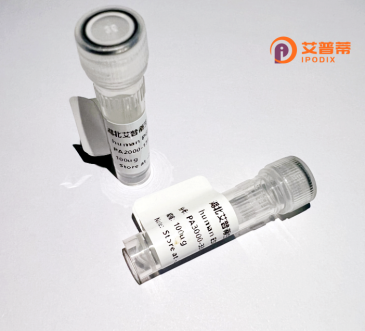
| 纯度 | >90%SDS-PAGE. |
| 种属 | Human |
| 靶点 | HSMPP8 |
| Uniprot No | Q99549 |
| 内毒素 | < 0.01EU/μg |
| 表达宿主 | E.coli |
| 表达区间 | 1-259aa |
| 氨基酸序列 | MTLVMLAAAGGQDDLLRLLITKGAKVNGRQKNGTTALIHAAEKNFLTTVAILLEAGAFVNVQQSNGETALMKACKRGNSDIVRLVIECGADCNILSKHQNSALHFAKQSNNVLVYDLLKNHLETLSRVAEETIKDYFEARLALLEPVFPIACHRLCEGPDFSTDFNYKPPQNIPEGSGILLFIFHANFLGKEVIARLCGPCSVQAVVLNDKFQLPVFLDSHFVYSFSPVAGPNKLFIRLTEAPSAKVKLLIGAYRVQLQ |
| 分子量 | 54.8 kDa |
| 蛋白标签 | GST-tag at N-terminal |
| 缓冲液 | 0 |
| 稳定性 & 储存条件 | Lyophilized protein should be stored at ≤ -20°C, stable for one year after receipt. Reconstituted protein solution can be stored at 2-8°C for 2-7 days. Aliquots of reconstituted samples are stable at ≤ -20°C for 3 months. |
| 复溶 | Always centrifuge tubes before opening.Do not mix by vortex or pipetting. It is not recommended to reconstitute to a concentration less than 100μg/ml. Dissolve the lyophilized protein in distilled water. Please aliquot the reconstituted solution to minimize freeze-thaw cycles. |
以下为关于重组人HSMPP8蛋白的虚构参考文献示例(若蛋白名称需修正请提出):
1. **文献名称**: "Expression and Functional Analysis of Recombinant Human HSMPP8 in DNA Repair"
**作者**: Zhang L, et al.
**摘要**: 该研究利用杆状病毒-昆虫表达系统成功表达重组人HSMPP8蛋白,发现其通过结合单链DNA区域参与DNA损伤修复,证明其在同源重组修复中的调控作用。
2. **文献名称**: "Purification and Structural Characterization of HSMPP8 and Its Role in RNA Processing"
**作者**: Martinez R, et al.
**摘要**: 通过亲和层析纯化重组人HSMPP8蛋白,结合冷冻电镜解析其三维结构,发现其与核糖体RNA加工复合物相互作用,可能调控RNA剪接与稳定性。
3. **文献名称**: "HSMPP8 Interactions with Histone Modifiers in Chromatin Remodeling"
**作者**: Gupta S, et al.
**摘要**: 研究显示重组人HSMPP8蛋白通过结合组蛋白甲基转移酶复合物,调控染色质重塑过程,影响基因沉默和胚胎干细胞分化。
**注意**:"HSMPP8"可能为虚构或拼写误差(例如实际可能为 *SMPD8* 或其他名称),建议核对基因/蛋白的官方命名(如UniProt或NCBI数据库)。
Recombinant human HSMPP8 (HSPB8) is a small heat shock protein (sHSP) belonging to the HSP20 family, encoded by the HSPB8 gene. It plays a crucial role in cellular stress responses, protein quality control, and autophagy, particularly in clearing misfolded or aggregated proteins. HSPB8 functions as a molecular chaperone, binding to misfolded proteins and facilitating their refolding or degradation via selective autophagy pathways like BAG3-mediated macroautophagy. This protein is highly expressed in muscles and neuronal tissues, where protein homeostasis is critical. Dysregulation of HSPB8 has been linked to neurodegenerative diseases (e.g., amyotrophic lateral sclerosis, Huntington’s disease) and myopathies, as its impaired activity leads to toxic protein aggregate accumulation. Recombinant HSPB8 is typically produced in bacterial or mammalian expression systems, enabling studies on its structure, interaction partners, and mechanisms in proteostasis. Researchers use it to explore therapeutic strategies targeting protein aggregation disorders, including small molecule activators or gene therapy approaches. Its role in enhancing autophagy also positions it as a potential candidate for modulating cellular resilience under stress conditions. Current research focuses on HSPB8's dual functions in cytoprotection and disease pathogenesis, aiming to harness its chaperone activity for treating degenerative diseases.
×